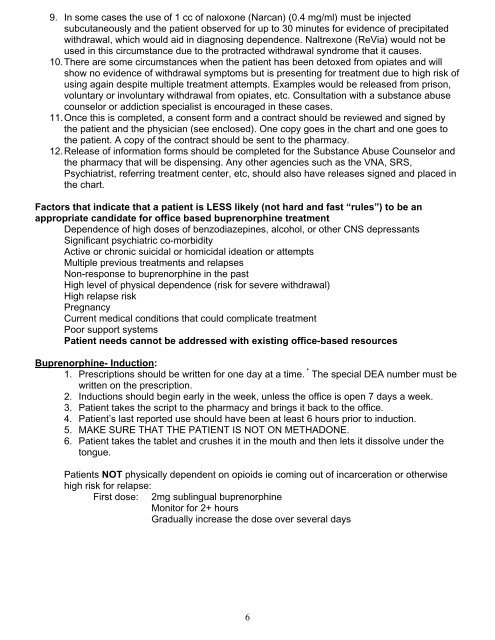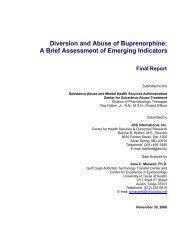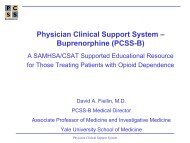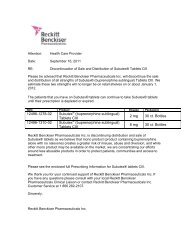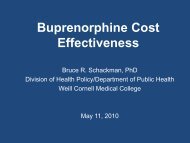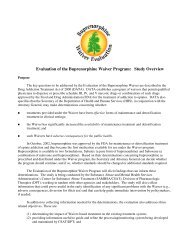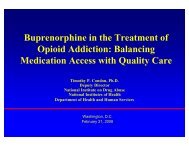Diversion and Abuse of Buprenorphine: A Brief Assessment of ...
Diversion and Abuse of Buprenorphine: A Brief Assessment of ...
Diversion and Abuse of Buprenorphine: A Brief Assessment of ...
You also want an ePaper? Increase the reach of your titles
YUMPU automatically turns print PDFs into web optimized ePapers that Google loves.
9. In some cases the use <strong>of</strong> 1 cc <strong>of</strong> naloxone (Narcan) (0.4 mg/ml) must be injected<br />
subcutaneously <strong>and</strong> the patient observed for up to 30 minutes for evidence <strong>of</strong> precipitated<br />
withdrawal, which would aid in diagnosing dependence. Naltrexone (ReVia) would not be<br />
used in this circumstance due to the protracted withdrawal syndrome that it causes.<br />
10.There are some circumstances when the patient has been detoxed from opiates <strong>and</strong> will<br />
show no evidence <strong>of</strong> withdrawal symptoms but is presenting for treatment due to high risk <strong>of</strong><br />
using again despite multiple treatment attempts. Examples would be released from prison,<br />
voluntary or involuntary withdrawal from opiates, etc. Consultation with a substance abuse<br />
counselor or addiction specialist is encouraged in these cases.<br />
11.Once this is completed, a consent form <strong>and</strong> a contract should be reviewed <strong>and</strong> signed by<br />
the patient <strong>and</strong> the physician (see enclosed). One copy goes in the chart <strong>and</strong> one goes to<br />
the patient. A copy <strong>of</strong> the contract should be sent to the pharmacy.<br />
12.Release <strong>of</strong> information forms should be completed for the Substance <strong>Abuse</strong> Counselor <strong>and</strong><br />
the pharmacy that will be dispensing. Any other agencies such as the VNA, SRS,<br />
Psychiatrist, referring treatment center, etc, should also have releases signed <strong>and</strong> placed in<br />
the chart.<br />
Factors that indicate that a patient is LESS likely (not hard <strong>and</strong> fast “rules”) to be an<br />
appropriate c<strong>and</strong>idate for <strong>of</strong>fice based buprenorphine treatment<br />
Dependence <strong>of</strong> high doses <strong>of</strong> benzodiazepines, alcohol, or other CNS depressants<br />
Significant psychiatric co-morbidity<br />
Active or chronic suicidal or homicidal ideation or attempts<br />
Multiple previous treatments <strong>and</strong> relapses<br />
Non-response to buprenorphine in the past<br />
High level <strong>of</strong> physical dependence (risk for severe withdrawal)<br />
High relapse risk<br />
Pregnancy<br />
Current medical conditions that could complicate treatment<br />
Poor support systems<br />
Patient needs cannot be addressed with existing <strong>of</strong>fice-based resources<br />
<strong>Buprenorphine</strong>- Induction:<br />
1. Prescriptions should be written for one day at a time. * The special DEA number must be<br />
written on the prescription.<br />
2. Inductions should begin early in the week, unless the <strong>of</strong>fice is open 7 days a week.<br />
3. Patient takes the script to the pharmacy <strong>and</strong> brings it back to the <strong>of</strong>fice.<br />
4. Patient’s last reported use should have been at least 6 hours prior to induction.<br />
5. MAKE SURE THAT THE PATIENT IS NOT ON METHADONE.<br />
6. Patient takes the tablet <strong>and</strong> crushes it in the mouth <strong>and</strong> then lets it dissolve under the<br />
tongue.<br />
Patients NOT physically dependent on opioids ie coming out <strong>of</strong> incarceration or otherwise<br />
high risk for relapse:<br />
First dose: 2mg sublingual buprenorphine<br />
Monitor for 2+ hours<br />
Gradually increase the dose over several days<br />
6


